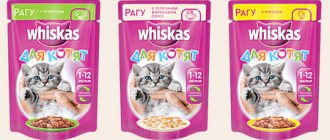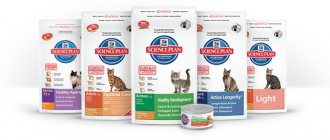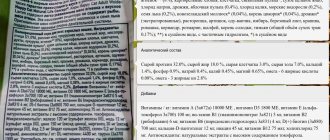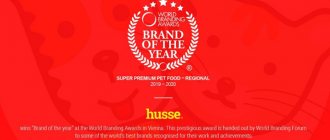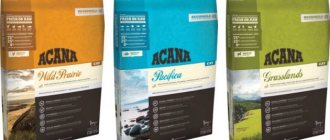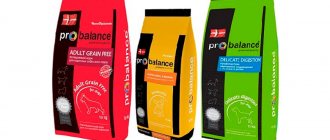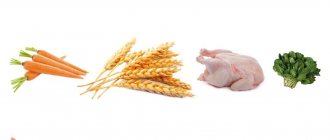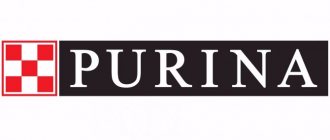Everyone knows about Whiskas food for kittens, even children. It has been produced for a very long time - since the 50s of the last century and throughout this time this brand has not lost popularity. This is not surprising, because a memorable advertisement for Whiskas food with a cute gray cat and the slogan “Your pussy would buy Whiskas” are constantly flashing on TV screens.
The products of this manufacturer can be purchased in any store at a very affordable price, and from a wide range of diets, every kitten owner will be able to choose food with a suitable taste for their pet. But whether this food is as good as it is presented in advertising should be found out.
Is it possible to give Whiskas to kittens?
Many people have a stereotype that it is impossible for a kitten to get all the substances necessary for full development from natural food. That’s why ready-made food in dry or wet form is so popular today. Every person who has a small fluffy ball in their home remembers the advertisement about Whiskas and wonders: is it possible to make it a permanent diet for their pets? This food, as you know, belongs to the economy class, which means there can be no talk of any high quality. Therefore, when giving food to a kitten, it is impossible to predict how its body will react to such food.
But if, nevertheless, the owner of a kitten decides to feed his pet Whiskas, it must be done correctly.
Reviews
I heard that Whiskas is not the best option for cats. But we are buying for the country cat Vasily, who goes around all the houses in the summer and collects “tribute”. We feed Whiskas in the evenings. Every summer for the fourth year now, it provides variety and entertainment for the children. Varya, 19 years old
I bought Whiskas because I ran out of stock in the freezer. In general, the kitten grows up on natural food. I did, even though I know that you can’t mix. He ate it, didn’t wince, and asked for more. We were on it for several days, no negative consequences appeared. Marina, 26 years old
In line at the veterinarian, I observed a Brit with swollen eyes and fur that had seen better days. The owner said that this was the result of feeding Whiskas - an allergy. It started after a week of feeding dry food. As a result, the veterinarian discovered an allergy to chicken protein and prohibited the purchase of food with chicken (any kind, because if you are allergic to protein, it does not matter what is written on the packaging). I was shocked: how can you not know what a cat is allergic to, he’s already old((Our cat eats the same food, because I know for sure that he has no allergies. Katya, 23 years old
How to give
If a kitten eats Whiskas no more than once a month, then there should be no consequences for its body. It happens that a kitten has to be left at home alone for more than half a day, then Whiskas is suitable as a one-time meal. It’s just important not to forget to leave him enough water. For such a case, Whiskas will be very useful.
Interesting video:
But it is not recommended to purchase it for a kitten as a treat, even occasionally. It is better to give him a natural treat that will benefit the small, vulnerable organism.
Whiskas diets for kittens from 1 to 12 months
The food rations of this manufacturer are distinguished by a variety of tastes. The assortment includes:
- Delicious pillows with milk, turkey and carrots . This is a dry food, sold in packages of 350 g and 1.9 kg. It is produced in the form of crispy pillows containing milk inside.
The composition contains wheat flour, as well as poultry and turkey flour (minimum 4% in brown, yellow and red granules), meat and bone meal, protein plant extracts, rice, animal fat, brewer's yeast, sunflower oil, at least 4% carrots (in brown, yellow and red granules), dairy products (minimum 4% milk solids in the pads), taurine, minerals and vitamins.
- Stew with lamb . Wet food, which is complete and essential for a growing body. Your little one will definitely love the little pieces of tender lamb in a delicious sauce.
The stew contains meat with offal (including at least 4% lamb), vegetable oil, minerals with vitamins and taurine.
- Stew with chicken. Wet food, which is complete and essential for a growing body. Your little one will definitely love the small pieces of tender chicken in a delicious sauce.
The stew contains meat with by-products (minimum 4% chicken), vegetable oil, cereals, minerals with vitamins and taurine.
- Stew with salmon . Wet food, which is a balanced diet, so necessary for the full development of a kitten. He will definitely love the tender little pieces with salmon that has a pleasant aroma.
The food contains meat and by-products (minimum 4% salmon), vegetable oil, cereals, minerals, vitamins, and taurine.
- Veal jelly . Wet food, which is a balanced diet, so necessary for the full development of a kitten. He will definitely love the tasty meat pieces with veal in aromatic jelly.
The food contains meat and offal (minimum 4% veal), vegetable oil, minerals, vitamins, and taurine.
- Turkey jelly . Wet food, which is a balanced diet, so necessary for the full development of a kitten. He will definitely love the delicious meat pieces with turkey in aromatic jelly.
The food contains meat and offal (at least 4% turkey), vegetable oil, minerals, vitamins, and taurine.
- Chicken pate . Wet food, which is a balanced diet, so necessary for the full development of a kitten. He will definitely love the tender meat pate with chicken.
The food contains meat and offal (minimum 25% chicken), vegetable oil, minerals, vitamins, and taurine.
What's in stock
The Whiskas food range includes both dry and wet food. The dry product is mainly represented by pillows with milk or pate filling. Wet food has a much greater variety - the manufacturer produces jelly, stew, pate, cream soup and other products. The manufacturer recommends feeding your pet wet food in the morning and evening, and dry food during the day. The main thing is not to mix different types in one bowl.
The division also concerns the age principle. You can choose separate food for a kitten, an adult cat, and also for an older pet. This division makes it possible to take into account all the nutritional characteristics of animals at different ages. Kittens require a higher intake of protein, vitamin D and calcium for the normal development of the musculoskeletal system. Elderly pets require additional intake of chondroprotectors from food, as well as a different ratio of macronutrients.
For adult pets
Products for adult pets are represented in several lines. First of all, this concerns the division by age. The body of a 3-year-old cat is significantly different from that of an 8-year-old cat, which is also due to the special needs of older pets. Whiskas takes these features into account and produces separate products for adult cats (up to 7 years) and elderly cats (after 7 years).
Whiskas food for cats over 8 years old Whiskas food for cats over 1 year old Whiskas food for cats over 7 years old
The line for adult pets is represented by the following products:
- Wet food in the form of a stew. It comes in turkey, fish, rabbit, beef and lamb flavors. Flavors can be combined.
- Mini fillet of chicken, rabbit or beef.
- Cream soup with beef or chicken flavor.
- Jelly with meat or fish.
- Pads with pate filling.
- Pate with the taste of poultry, fish or beef.
Separately, Whiskas has a line for sterilized and neutered pets. It is presented only as dry food in the form of pads with different fillings. Such nutrition allows you to take into account the pet’s condition and its changing needs. Therefore, before spaying or neutering your pet, take care of switching to a new diet.
For kittens
Whiskas for small kittens can also be presented in several types:
- Wet food in the form of jelly. It comes in turkey or veal flavor.
- Stew with lamb, salmon, chicken.
- Chicken pate.
- Dry pads with milk filling and turkey flavor.
You can feed a kitten with such products from the age of one month. Until this period, the kitten should be fed exclusively on mother's milk. After 1 year, the pet is transferred to adult food.
Feed composition
As an example to analyze the composition of Whiskas for kittens, you can take “pads with milk filling, turkey and carrots.”
- The first ingredient on the package is wheat flour, which is a source of carbohydrates; rice is the same source. The amount of flour present in the feed is unknown, as is the percentage of other feed components. But since flour comes first, we can assume that there is more than half of it in the feed.
- The second ingredient is flour of animal origin, that is, from turkey, poultry and meat and bone. But there is no information on the packaging about what parts of turkey and poultry were used in the production of the food and the exact percentage.
- Next come protein plant extracts, but their percentage is again unknown.
- Since poultry meal, meat-and-bone and wheat flour, as well as rice contain a small amount of protein, most likely of the 34% of protein present in the food, a significant part belongs to vegetable protein, which is more difficult for the cat’s body to digest.
- The feed contains sunflower oil and animal fat as sources of fatty acids, but it is not known which animals it comes from.
- The source of B vitamins is brewer's yeast, and the source of fiber is carrots.
- The remaining ingredients are various additives.
Whiskas cat food
Whiskas is one of the most popular brands of cat food. The trademark is owned by Mars, and the brand representative is Masterfoods. The manufacturer claims that the food formulation was developed based on numerous studies by the Waltham Research Center and approved by the Russian Association of Veterinarians.
Whiskas is one of the leaders in the economy class cat food market
Historical note: Frank S. Mars (Minnesota) was born in 1882. He suffered from polio, so as a child he was educated at home. His mother taught him how to make chocolate, and he spent all his time in the kitchen. In 1902, he married and started his own small business selling molasses chips. After 9 years, he began making and selling chocolate bars. In 1923, Mars began to be considered a successful businessman, as his product, Milky Way chocolate, gained popularity from the first days. After this, other products began to appear, which are now still selling successfully.
In 1934, Mars died, and his eldest son, Forest, had to take over the business. It was he who decided to add pet food to the company's treasury. True, this was only possible after the war. In 1960, Forest and the company merged. The first Russian enterprise from Mars appeared in 1995 (Moscow region). This is how the organization entered the world market. After 3 years, Forest Mars passed away, but once founded, it continued to gain momentum. The products of this manufacturer are in great demand all over the world. Currently, the company has representative offices in every progressive country in the world.
In addition to Whiskas, Mars has other brands:
- Pet products: Pedigree, Royal Canin, Kitecat, Cesar, Nutro, Sheba, Chappi, Catsan, Frolic, Perfect Fit, etc.
- Chocolate brands: M&M'S, Snickers, Dove, Mars, Milky Way, Twix, Balisti, Bounty, Maltesers, Revels, etc.
- Food products: Uncle Ben's, Dolmio, Masterfoods, Seeds Of Change, Ebly, Royco, Kan Tong, Suzi Wan, Paris, etc.
- Confectionery brands: Extra, Orbit, Altoids, DoubleMint, Juicy Fruit, Life Savers, Skittles, Wrigley's Spearmint, Starburst, etc.
What class does Whiskas food belong to?
Rebranding and advertising of food may indicate that it belongs to economy class food
Cat food may fall into one of the following classes:
- economy;
- premium;
- super premium;
- holistic.
Belonging to one of these classes is determined by the quantity and quality of meat. For example, holistic food can contain up to 90% meat. We are not talking about animal proteins (offal, bone meal, etc.), but about meat (for example, fresh lamb in Akana food). Such products cannot contain dyes or flavors; they are natural and, accordingly, have a high price. You can buy such food only in specialized stores. Such a product does not need advertising, so novice cat breeders know little about such food for cats.
Super premium class has less meat content. However, the composition should predominantly contain proteins of animal origin. Some foods in this class contain flavorings and preservatives. In terms of price, they are almost no different from holistic ones.
But the premium class means cheaper products. Premium cat food can be found in a regular pet store; it may contain dyes, preservatives, and flavorings. Meat, as a rule, is about 35% in this food. Moreover, this meat may not be of the highest quality (that’s why flavorings are needed). refer their products to this class. But some veterinarians believe this is just a publicity stunt. The basis for this opinion was the analysis of the composition. In addition, usually only the simplest products need powerful and aggressive advertising, for which PR is the only way to stay in the market.
Food advertising can be very convincing, but this is not due to the high quality of the product
Economy class food contains very little meat. Moreover, these will be derivatives of meat products (animal flour, etc.). The diet will be based on grains and plant ingredients. So that the plants in the composition do not confuse the buyer, they are usually designated by a single inaccurate word - “cereals”, etc. Meat components, on the contrary, are separated in as much detail as possible so that the composition looks as if it contains a lot of products of animal origin and plant origin. There are no components at all.
The energy value in this food is achieved thanks to vegetable proteins (corn gluten, etc.). There will also be no special components (for example, fruits or rare herbs) in such a product. There will be a bare minimum of vitamins and mineral components. The food will contain coloring (to give it an appetizing appearance), preservatives (since low-cost production technologies do not allow for long-term storage) and flavorings (otherwise the cat may simply refuse such food). Moreover, the “smallest” components in the form of, for example, dyes may not be indicated (so as not to frighten buyers with the abundance of the letter E in the composition).
One of my friends buys only cheap food for her cat. But at the same time, she studies the label every time for half an hour, claiming that she strictly follows the rules of the diet - how much protein a cat should receive and how much carbohydrates. In fact, cats (and they are natural predators) need animal protein. Even if these are just processed meat products, they are better than vegetable protein. In addition, my friend does not take artificial ingredients into account (I am usually confused by the fact that the percentage of an undesirable ingredient is not indicated).
When choosing food, you should always study the composition of the product (it is always indicated on the packaging - on the back or side)
Veterinarians' opinion
If you listen or read reviews from veterinarians, you can see that almost all of them agree that Whiskas should not be fed not only to kittens, but also to adult cats. No matter what kind of food (wet or crushed dry) a kitten is given, it will not grow up healthy. Sooner or later he will begin to have health problems, because the daily portion of Whiskas contains a tiny amount of protein (only 5%) and harmful chemicals.
Of course, there will be people who are ready to argue with this, and will give more than one example of how cats eat only Whiskas for years and feel great without any health problems. But before drawing any conclusions, it would be a good idea to carefully analyze such cases. Most likely we are talking about non-pedigreed cats, since their bodies are resistant to even the most severe influences. And in fact, such animals can live 5-7 years without illness, eating low-quality food. But then they will still start to get sick and will live no more than 9 years, not reaching the required 15.
Interesting video: Whiskas kills cats
An owner who loves his pet and wants it to grow up active and healthy will never skimp on its food. He will choose expensive ready-made premium food or will feed the animal with good quality natural food, which will be healthier than any ready-made food.
Advantages and disadvantages of diets
The advantages include the availability of Whiskas. This applies not only to the low cost, but also to the fact that the product can be bought in any store.
The disadvantages of this product include the following:
- Low content of animal proteins. In addition, the label does not indicate the specific amount and source (is it meat or just offal). This makes the food of poor quality and is the main reason why it should not be used as a daily diet.
- Insufficient amount of meat (no more than 4%).
- Contains grains that can cause allergic reactions or indigestion.
- The composition does not indicate the percentage of almost all components. One can only guess how much meat is contained and how much is grains.
“Whiskas” cannot be called a high-quality food; it is quite possible that its use may have a negative impact on the pet’s health.
The main advantage is low cost, which is why many owners prefer this product.
Recommended Posts
Standard height and weight of the Cane Corso breed by month
Weight of a puppy and an adult Labrador by month
Weight and height of a German Shepherd puppy by month
Description and content of the hunting border terrier
Description and care of the highly intelligent Border Collie breed
Description of forms and features of treatment of enteritis in cats
Pros and cons of Whiskas food
As mentioned above, Whiskas food is produced in dry and wet form, giving kitten owners a choice. But only the owner, and not his pet, can discover any advantages in food that belongs to the economy class. And the statement “your pussy would buy Whiskas” has nothing to do with the truth. A kitten who eats budget food with great appetite does so only because of the presence of various chemicals in it, which cause gradual addiction to this food and a desire to eat it. It's similar to how people get addicted to drugs.
According to kitten owners, the advantages of Whiskas include:
- Ease of feeding . If you don’t have enough time, feeding your kitten with ready-made food is very convenient; you only need to spend a couple of minutes on the whole process. Since the food is already ready, all you need to do is open the pack and put it in a bowl. Even a child can cope with feeding a kitten.
- Avoiding food spoilage . Those who have a kitten left alone for the whole day put a portion of dry food in a bowl designed for this time, and can rest assured that the food will not spoil and the kitten will not be poisoned after eating it.
- Eating food with appetite . A kitten may adore Whiskas, but not for its quality composition, but for the chemical components contained in the food in large quantities.
- Low cost of feed . The kitten owner may like this because he won't have to spend a lot of money on his pet. But this is only an appearance, but in fact, having carefully calculated the funds spent on the purchase of ready-made food, it will become clear that natural food will be much cheaper.
As for the disadvantages of Whiskas, they are associated with the condition of the kitten. If he feeds only on it, his health will be undermined in a short time. An animal that grew up on such food will no longer be able to live a full life, even if the owner later switches it to feeding high-quality natural food.
So, the main disadvantages are:
- Bad composition . He will not be able to saturate the kitten with the required amount of proteins, microelements and vitamins, so with such a diet there will be no full development. And if the kitten grows well outwardly, then its insides are still not formed correctly. Sooner or later, problems will begin with the baby's health.
- Presence of addictive chemical components . Eating only Whiskas, the kitten gets used to these substances, and then it will be very difficult to switch it to nutritious food.
- Development of urolithiasis . This is due to an increase in the level of mineral salts in the urine. Normally, a kitten should drink a glass of water after eating 100 g of food. But it is clear that this is impossible, and the baby gradually begins to develop this disease from childhood.
conclusions
| pros | minuses |
| Price | Disease risks* |
| Variety of flavors | Addictive** |
| Availability of outlets | Contains a small amount of meat |
*Based on user reviews, not scientifically proven. In addition to the increased likelihood of obesity and diseases associated with excess weight. **Relevant for dry food with a high content of flavors and flavor enhancers.
Whiskas is an economy class food and this is exactly what you need to know about it. The food contains a small amount of meat, and its absence is compensated by specially prepared vegetable proteins and carbohydrates, which, if portion sizes and diet are not followed, can cause a number of diseases. It’s also not worth demonizing food. The Whiskas brand belongs to a corporation with huge capacities and a rich history of producing animal feed. All Whiskas food products are tested and tested for toxicity and only after their safety is confirmed are they put on the shelf. However, it is better to opt for higher quality feeds, such as Arden Grange or Perfect Fit.
Whatever food you choose, follow the storage rules for dry and wet food.
Tags: Nutrition
